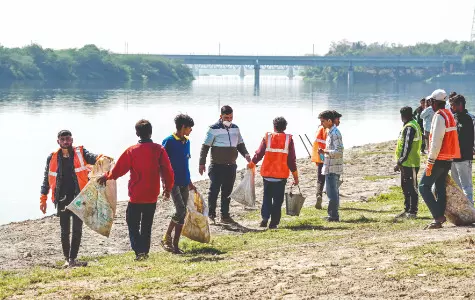
NEW DELHI, March 9 -- For generations, farmers cultivated the fertile lands of the Yamuna Khadar floodplains, sustaining their families through agriculture. But in recent years, their way of life has been upended-first by official restrictions, then by bulldozers. Now, as large-scale beautification projects take over the floodplains, these farmers find themselves displaced, without compensation or rehabilitation. Lalit, 47, a farmer whose family had worked the land for five generations, recalls the sudden loss. "First our crops were razed, and then our homes," he said. The construction of Yamuna Vatika, a Delhi Development Authority (DDA) project, has taken over land where their fields once flourished. Many like him have been forced to the periphery, living in makeshift shelters with no access to basic amenities.
The turning point came in 2019 when the National Green Tribunal (NGT) imposed a ban on all farming activities in the Yamuna floodplains. This decision was driven by a study conducted by the National Environmental Engineering Research Institute (NEERI), which found dangerously high levels of lead in vegetables and corresponding soil samples from the floodplains. Additionally, the Central Pollution Control Board (CPCB) reported that the excessive use of fertilisers and pesticides by farmers was significantly polluting the Yamuna's water and its surrounding floodplains.
While environmental concerns were cited as the reason for the farming ban, the subsequent actions by authorities have raised serious questions. Farmers argue that their forced eviction was not just about protecting the floodplains but about paving the way for government-led beautification projects. "Floodplains are very important to the river ecosystem, and look at the condition of the Yamuna in Delhi-it's on its deathbed," said Suraj Suman, an environmental activist. "It's essential to let the floodplains be naturally inhabited and not concretised. Urban farming can improve the city's food security and keep it green."
Despite NGT's strict guidelines barring any form of construction or concretisation on the Yamuna floodplains, the DDA has pressed forward with beautification and redevelopment projects. Near Rajghat, where the Asita West project is underway, several farmers have been displaced in the process. On the west bank, a wired boundary wall and pillars now enclose the floodplain, cutting off access. In the past three to four years, they claim, their crops were systematically destroyed, and nearly 700 jhuggis (slum dwellings) were demolished. Now, many of these displaced farmers live just outside the boundary, in makeshift plastic shelters. "The DDA routinely demolishes our jhuggis and destroys our crops. We no longer even build jhuggis; we just stay beneath plastic sheets," said one farmer. "Nowhere to go, despite having all the documents," lamented Rita Devi, recalling how her house was bulldozed while materials for park construction were being delivered. She questioned, "How can we be blamed for the Yamuna's deterioration? Aren't natural plants better for the river than these artificial parks?"
For over two years, farmers have been protesting for rehabilitation and land for farming, which was once their only source of livelihood. Their makeshift settlements lack drinking water, toilets, and electricity. "This boundary wall was put up to throw us out, and since then, we haven't been rehabilitated or compensated," said another displaced farmer.
While the government removed farmers and their homes to prevent settlement on the Yamuna floodplains, DDA's restoration projects involve plantation, construction, and concretisation. The very land from which farmers were expelled is now being transformed into structured parks, growing concerns over whether these beautification projects truly serve the environment-or simply displace those who once depended on it.
Published by HT Digital Content Services with permission from Millennium Post.
